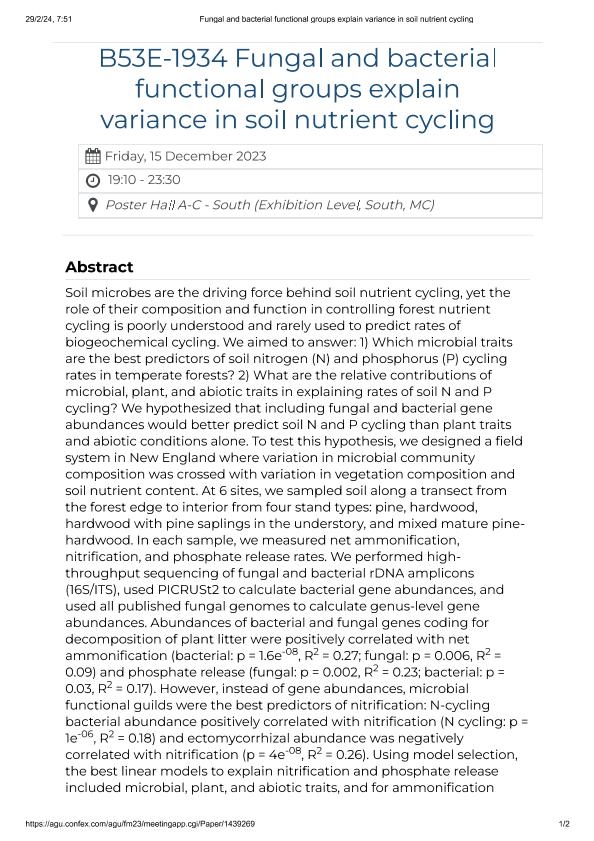Mostrar el registro sencillo del ítem
dc.contributor.author
Vietorisz, Corinne
dc.contributor.author
Policelli, Nahuel

dc.contributor.author
Li, Abigail
dc.contributor.author
Bhatnagar, Jennifer M.
dc.contributor.author
Adams, Lindsey
dc.date.available
2024-02-29T10:51:43Z
dc.date.issued
2023
dc.identifier.citation
Fungal and bacterial functional groups explain variance in soil nutrient cycling; American Geophysical Union 2023 meeting; San Francisco; Estados Unidos; 2023; 1-2
dc.identifier.uri
http://hdl.handle.net/11336/228885
dc.description.abstract
Soil microbes are the driving force behind soil nutrient cycling, yet the role of their composition and function in controlling forest nutrient cycling is poorly understood and rarely used to predict rates of biogeochemical cycling. We aimed to answer: 1) Which microbial traits are the best predictors of soil nitrogen (N) and phosphorus (P) cycling rates in temperate forests? 2) What are the relative contributions of microbial, plant, and abiotic traits in explaining rates of soil N and P cycling? We hypothesized that including fungal and bacterial gene abundances would better predict soil N and P cycling than plant traits and abiotic conditions alone. To test this hypothesis, we designed a field system in New England where variation in microbial community composition was crossed with variation in vegetation composition and soil nutrient content. At 6 sites, we sampled soil along a transect from the forest edge to interior from four stand types: pine, hardwood, hardwood with pine saplings in the understory, and mixed mature pine-hardwood. In each sample, we measured net ammonification, nitrification, and phosphate release rates. We performed high-throughput sequencing of fungal and bacterial rDNA amplicons (16S/ITS), used PICRUSt2 to calculate bacterial gene abundances, and used all published fungal genomes to calculate genus-level gene abundances. Abundances of bacterial and fungal genes coding for decomposition of plant litter were positively correlated with net ammonification (bacterial: p = 1.6e-08, R2 = 0.27; fungal: p = 0.006, R2 = 0.09) and phosphate release (fungal: p = 0.002, R2 = 0.23; bacterial: p = 0.03, R2 = 0.17). However, instead of gene abundances, microbial functional guilds were the best predictors of nitrification: N-cycling bacterial abundance positively correlated with nitrification (N cycling: p = 1e-06, R2 = 0.18) and ectomycorrhizal abundance was negatively correlated with nitrification (p = 4e-08, R2 = 0.26). Using model selection, the best linear models to explain nitrification and phosphate release included microbial, plant, and abiotic traits, and for ammonification included microbial and abiotic traits. Our results show that multiple microbial traits are important predictors of soil N and P cycling and should be included in future ecosystem-level biogeochemistry models.
dc.format
application/pdf
dc.language.iso
eng
dc.publisher
American Geophysical Union

dc.rights
info:eu-repo/semantics/openAccess
dc.rights.uri
https://creativecommons.org/licenses/by-nc-sa/2.5/ar/
dc.subject
NITROGEN
dc.subject
CARBON
dc.subject
MICROBIAL COMMUNITY
dc.subject
SOIL
dc.subject.classification
Ecología

dc.subject.classification
Ciencias Biológicas

dc.subject.classification
CIENCIAS NATURALES Y EXACTAS

dc.title
Fungal and bacterial functional groups explain variance in soil nutrient cycling
dc.type
info:eu-repo/semantics/publishedVersion
dc.type
info:eu-repo/semantics/conferenceObject
dc.type
info:ar-repo/semantics/documento de conferencia
dc.date.updated
2023-12-26T14:15:22Z
dc.journal.pagination
1-2
dc.journal.pais
Estados Unidos

dc.journal.ciudad
San Francisco
dc.description.fil
Fil: Vietorisz, Corinne. Boston University; Estados Unidos
dc.description.fil
Fil: Policelli, Nahuel. Consejo Nacional de Investigaciones Científicas y Técnicas. Centro Científico Tecnológico Conicet - Centro Nacional Patagónico. Instituto Patagónico para el Estudio de los Ecosistemas Continentales; Argentina
dc.description.fil
Fil: Li, Abigail. Boston University; Estados Unidos
dc.description.fil
Fil: Bhatnagar, Jennifer M.. Boston University; Estados Unidos
dc.description.fil
Fil: Adams, Lindsey. Boston University; Estados Unidos
dc.relation.alternativeid
info:eu-repo/semantics/altIdentifier/url/https://agu.confex.com/agu/fm23/meetingapp.cgi/Paper/1439269
dc.conicet.rol
Autor

dc.conicet.rol
Autor

dc.conicet.rol
Autor

dc.conicet.rol
Autor

dc.conicet.rol
Autor

dc.coverage
Internacional
dc.type.subtype
Reunión
dc.description.nombreEvento
American Geophysical Union 2023 meeting
dc.date.evento
2023-12-11
dc.description.ciudadEvento
San Francisco
dc.description.paisEvento
Estados Unidos

dc.type.publicacion
Book
dc.description.institucionOrganizadora
American Geophysical Union
dc.source.libro
American Geophysical Union (AGU) 2023 meeting
dc.date.eventoHasta
2023-12-15
dc.type
Reunión
Archivos asociados
